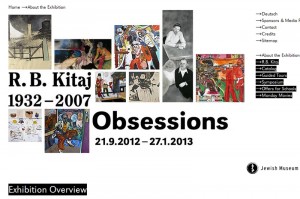The Tate War
Kitaj tended to accompany his painting with written commentaries, and in the early 1990’s, he was more immersed than ever in Jewish studies. His 1994 retrospective at the Tate Gallery in London reflected that emphasis on Jewish sources. Some art critics, however, found this textualization disturbing and argued that he had surrendered the integrity of the visual image to ideas and words: “No amount of exegesis will improve paintings that fail for pictorial reasons”.

R. B. Kitaj (1932-2007) Obsessions. A retrospective exhibition at the Jewish Museum Berlin from 21st September 2012 – 27th January 2013. The catalogue to the exhibition was published by Kerber Verlag in German and English
Was his work too Jewish? The negative reviews caused deepest disappointment and his return to the U.S. after 40 years. Some weeks after the “Tate War”, his second wife Sandra Fisher died of a ruptured aneurysm at age forty-seven. Kitaj blamed the critics’ cruelty: “They tried to kill me, and they got her instead”. In 1995, the Metropolitan Museum of Art restaged the Tate retrospective, to positive reviews. In Los Angeles, R. B. Kitaj led a largely reclusive life, painting and writing until his suicide on October 21, 2007.
Complex images
The last time Kitaj’s works were on show in Germany was in 1998 when the Sprengel Museum in Hannover presented “An American in Europe”. The exhibit in Berlin brings together loans by leading museums and private collections from around the world. One hundred thirty paintings, prints and drawings from all periods of his oeuvre are being shown in ten theme rooms. For the first time, the Jewish Museum Berlin had access to the complete estate of the artist’s “Yellow Studio” in Los Angeles.
Thanks to the opportunity to view his extensive private archive of texts and pictures, which served as an inspiration for his paintings and collages, the exhibition provides unique insights into his art. It shows the elements, examples and inspirations that Kitaj drew on to compose his pictures and reveals how he himself saw them. Commentaries of the artist have been recorded and are available on audio guide, so that visitors have the chance to hear Kitaj himself speak about his work.
Symposium explores Kitaj’s art
“It surprises me that Kitaj is not as well-known in Germany as his London contemporaries Lucian Freud and Frank Auerbach”, says museum curator Michal Friedlander. “I think that the exhibition will be a revelation. I am particularly looking forward to seeing the portrait of my father Rabbi Albert H. Friedlander z”l, as I only know it from photographs.”
To mark Kitaj’s 80th birthday this year, the Jewish Museum Berlin is holding a symposium in cooperation with the Academy of the Arts on October 25th/26th with speakers from Germany, the UK and the U.S.

